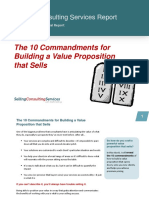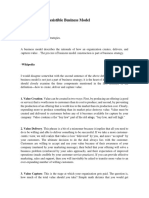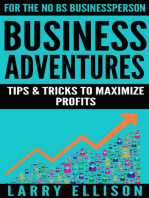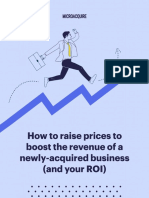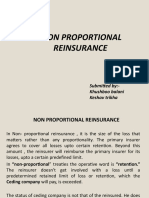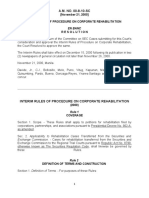100M Offers 1
100M Offers 1
Uploaded by
FlorentCopyright:
Available Formats
100M Offers 1
100M Offers 1
Uploaded by
FlorentCopyright
Available Formats
Share this document
Did you find this document useful?
Is this content inappropriate?
Copyright:
Available Formats
100M Offers 1
100M Offers 1
Uploaded by
FlorentCopyright:
Available Formats
Part 1: Principles of Grand Slam Offers and Why They Are
Essential for Business
Alex Hormozi's Story and the Need for a Grand Slam Offer
Before understanding the concept of a Grand Slam Offer, you have to understand how I got
there. I wasn’t always running multi-million dollar companies. I started from the bottom,
broke and desperate, with only one shot left to save myself. In 2017, I’d poured my life
savings into a new business called Gym Launch, based on a methodology I'd created to fill
gyms to capacity. At that point, I was living in my girlfriend’s parents' spare room, $120,000
of my money was locked up by a payment processor, and I was on the verge of bankruptcy.
But with one last credit card and a Grand Slam Offer, I went from scraping by to making over
$100 million in the following years. That is the power of a Grand Slam Offer.
What Is a Grand Slam Offer?
A Grand Slam Offer is an offer so compelling that people feel stupid saying no to it. Imagine
an offer that’s not only different from every other option out there but also so valuable that
the customer feels they’d be missing out if they don’t take it. The goal is to remove all
barriers and make the offer irresistible.
As I say, “Make people an offer so good they’d feel stupid saying no.”
Think about it like this: a good offer may get a prospect interested, but a Grand Slam Offer
seals the deal without the need for persuasion. It creates immediate demand, pulls the
client out of their seat, and makes them take action because it feels like they have no other
option.
Why It’s Critical for Business
Without a Grand Slam Offer, your business will be forced into the grind of competing on
price, just another player in a commoditized market. But with a Grand Slam Offer, you
escape the commodity trap. Instead of competing with others on price, you create a
“category of one,” where there’s no comparison. This allows you to price your offer based on
the value it delivers, not based on what others charge. Businesses with Grand Slam Offers
grow faster, make more profit, and develop loyal clients. And when done right, a single
Grand Slam Offer can give you financial freedom for the rest of your life.
As I say, “The difference between a mediocre business and a great one is the skill of creating
offers.”
Part 2: Pricing – Key Principles for Setting Profitable Prices
In business, pricing is everything. If you set your price wrong, you're losing money on the
table before you've even started. Pricing can make or break your agency, especially if you
want to scale to $100,000 a month. Here are the critical pricing principles:
1. Avoid the Commodity Trap
When your offer is a commodity, you're stuck in a race to the bottom on price. It’s a
“price-driven” purchase. In a commoditized market, the customer has no reason to pick your
service over a cheaper alternative. To escape this, your offer must be unique –
differentiated by immense value that only your offer delivers. The goal is to make your offer
incomparable, so the prospect doesn’t see other alternatives as even close.
As Steve Jobs said, “Think different.” And that’s exactly what pricing a differentiated,
value-driven offer means.
2. Charge What It’s Worth – Not What the Market Will Bear
You need to understand the true value of your service to set your price right. I always say,
“Charge what it’s worth.” Think in terms of what results your offer delivers and the pain it
solves for the client. What would that result be worth to them? If you can create an offer
that feels priceless to your client, they’ll pay any price to have it. Price isn’t just about
covering costs; it’s about capturing the value you deliver.
Here’s a simple exercise: If you’re helping a client make $50,000 more each month, why
would you charge them $1,000? You’re giving them a huge return on investment, so price
according to the transformation you deliver, not what competitors charge.
3. Find the Starving Crowd
As I share in the book, “You can sell a bad hot dog to a starving crowd faster than a gourmet
meal to someone who’s full.” When pricing, you must target clients who need what you’re
offering desperately. Find your “starving crowd,” the clients who have big pain points and are
willing to pay well to solve them. Your job is to solve big problems for people who recognize
the need and urgency for a solution.
4. Build Value into the Price
The biggest mistake I see entrepreneurs make is assuming their price only reflects their
time or costs. The real value in your pricing comes from everything else you add to the
offer: your expertise, the extra bonuses, the guarantee that makes it feel risk-free, and the
exclusivity of the solution you provide. Build these elements into the offer so that your client
is looking at a price packed with value – and, more importantly, feels like they’re getting a
steal for what you’re delivering.
5. Use Payment Plans and Premium Options
If you want to maximize revenue, structure your pricing to make the purchase easy and
attractive. Payment plans break down the price so that the client sees a smaller upfront
investment, but you’re still charging a premium. Premium options also create higher
perceived value. For example, if you offer a basic service, provide an exclusive, higher-ticket
version that adds personalized support or advanced features. Clients who are serious about
results will gravitate toward this option, which increases your average transaction size.
Final Words on Pricing
Pricing is a strategic tool. A high price says your offer is high-value, and a low price can
sometimes undermine the credibility of your service. Think of pricing as a means to
demonstrate your offer’s worth. If you do it right, pricing can be your strongest asset for
reaching $100,000 a month in revenue.
You might also like
- Jesus T. Peralta, PHD: in Focus: Why There Are No Tribes in The PhilippinesDocument5 pagesJesus T. Peralta, PHD: in Focus: Why There Are No Tribes in The PhilippinesRoshelle B. Caasi100% (1)
- Getting Everything You Can Out of All You've Got (Review and Analysis of Abraham's Book)From EverandGetting Everything You Can Out of All You've Got (Review and Analysis of Abraham's Book)Rating: 4.5 out of 5 stars4.5/5 (3)
- The 10 Commandments For Building A Value Propositionthat Sells PDFDocument28 pagesThe 10 Commandments For Building A Value Propositionthat Sells PDFelisaNo ratings yet
- PremiumizationDocument4 pagesPremiumizationFajar ikhwan rosyidiNo ratings yet
- $100M Offer NotesDocument3 pages$100M Offer Notesmessidylan10No ratings yet
- Agency Accelerator 20by @JoinNexuz PDFDocument8 pagesAgency Accelerator 20by @JoinNexuz PDFpriyanshuk.jha1No ratings yet
- The Art of Pricing (Review and Analysis of Mohammed's Book)From EverandThe Art of Pricing (Review and Analysis of Mohammed's Book)No ratings yet
- The Irresistible Value Proposition: Make the Customer Want What You're Selling and Want It NowFrom EverandThe Irresistible Value Proposition: Make the Customer Want What You're Selling and Want It NowRating: 5 out of 5 stars5/5 (1)
- Use Pricing Strategy To Boost SalesDocument5 pagesUse Pricing Strategy To Boost SalesTung NgoNo ratings yet
- 1.identify Five Pricing Strategies Being Effectively Used by Retail OrganizationDocument6 pages1.identify Five Pricing Strategies Being Effectively Used by Retail OrganizationIsha JainNo ratings yet
- Marketing and Communications Strategies: The GuidesDocument11 pagesMarketing and Communications Strategies: The GuidesMirza Arsalan BaigNo ratings yet
- Week 002 - CUSTOMER RELATIONSHIP - CUSTOMER SERVICE z2GdBSDocument8 pagesWeek 002 - CUSTOMER RELATIONSHIP - CUSTOMER SERVICE z2GdBSAbdulhakim MautiNo ratings yet
- Pricing Stategies-RfDocument10 pagesPricing Stategies-Rfbox750994No ratings yet
- What Is Meant by PricingDocument4 pagesWhat Is Meant by PricingChristine Joyce MagoteNo ratings yet
- A Joosr Guide to... The Challenger Sale by Matthew Dixon and Brent Adamson: How to Take Control of the Customer ConversationFrom EverandA Joosr Guide to... The Challenger Sale by Matthew Dixon and Brent Adamson: How to Take Control of the Customer ConversationRating: 5 out of 5 stars5/5 (1)
- PricingDocument19 pagesPricingAmal JoseNo ratings yet
- 5 Low-Cost Ways To Improve Your Security Marketing Strategy: Customer Value PropositionsDocument3 pages5 Low-Cost Ways To Improve Your Security Marketing Strategy: Customer Value PropositionsPradeep PanigrahiNo ratings yet
- The Personal MBA (Review and Analysis of Kaufman's Book)From EverandThe Personal MBA (Review and Analysis of Kaufman's Book)Rating: 3.5 out of 5 stars3.5/5 (3)
- Principles of MarketingDocument21 pagesPrinciples of MarketingJEVEL SAMUYANo ratings yet
- 100M Offer 2Document4 pages100M Offer 2FlorentNo ratings yet
- Peacock M. Pricing For Success. The 7-Step Plan For Winning More Customers..2023Document269 pagesPeacock M. Pricing For Success. The 7-Step Plan For Winning More Customers..2023Krishna ChaitanyaNo ratings yet
- Pricing Strategies For Marketing About Pricing StrategyDocument4 pagesPricing Strategies For Marketing About Pricing StrategySampath BanalaNo ratings yet
- 5 StrategiesDocument11 pages5 StrategiesKathrine CruzNo ratings yet
- Beginners Guide To SalesDocument19 pagesBeginners Guide To SalesJoannaCamyNo ratings yet
- Cost of Consulting ServicesDocument15 pagesCost of Consulting ServicesWeru CharlesNo ratings yet
- Money-Making Secrets of Marketing Genius Jay Abraham and Other Marketing Wizards (Review and Analysis of Abraham's Book)From EverandMoney-Making Secrets of Marketing Genius Jay Abraham and Other Marketing Wizards (Review and Analysis of Abraham's Book)Rating: 4 out of 5 stars4/5 (4)
- Module (4) Assignment 1Document2 pagesModule (4) Assignment 1Joy FrianezaNo ratings yet
- The Startup Report Getting The Value Equation RightDocument15 pagesThe Startup Report Getting The Value Equation Rightpadrepio2009No ratings yet
- Customer Value On Start Up CompanyDocument12 pagesCustomer Value On Start Up Companyathiq saktiNo ratings yet
- Stop Competing on Price: What every salesperson, entrepreneur and business professional needs to know to differentiate their product or service and make price irrelevant.From EverandStop Competing on Price: What every salesperson, entrepreneur and business professional needs to know to differentiate their product or service and make price irrelevant.Rating: 4 out of 5 stars4/5 (1)
- Advertising Doesn't Have To Wipe OutDocument2 pagesAdvertising Doesn't Have To Wipe OutRukshan FiverrNo ratings yet
- Perfect Your Sales Pitch To Convert More CustomersDocument10 pagesPerfect Your Sales Pitch To Convert More Customerskapoor_mukesh4uNo ratings yet
- Idea For Business TodayDocument4 pagesIdea For Business Todaychemat86No ratings yet
- CHAPTER III. Pricing StrategiesDocument10 pagesCHAPTER III. Pricing StrategiesMa. Lotie Torres VillamarinNo ratings yet
- Cara Menentukan Pricing StrategiesDocument12 pagesCara Menentukan Pricing StrategiesRief RobyNo ratings yet
- Smart Pricing (Review and Analysis of Raju and Zhang's Book)From EverandSmart Pricing (Review and Analysis of Raju and Zhang's Book)Rating: 4 out of 5 stars4/5 (1)
- Chapter 6 The Importance of Having An OfferDocument2 pagesChapter 6 The Importance of Having An OfferRuth Isabel Laynes CuNo ratings yet
- Damat HotelDocument13 pagesDamat HotelSAMUALE ASSEFA MEKURIYANo ratings yet
- Selling The Service-SummarizedDocument8 pagesSelling The Service-SummarizedMozart ReinaNo ratings yet
- 3 Steps To An Irresistible Business Model PDFDocument3 pages3 Steps To An Irresistible Business Model PDFjaimequintoNo ratings yet
- Principles of MarketingDocument22 pagesPrinciples of MarketingJEVEL SAMUYANo ratings yet
- Freelance Tips - InkDealsDocument44 pagesFreelance Tips - InkDealsClaire GarnierNo ratings yet
- SHS S: Principles of MarketingDocument13 pagesSHS S: Principles of Marketingangel annNo ratings yet
- How To Write A Killer Proposition (Even If You're Not A Writer) and Win New BusinessDocument24 pagesHow To Write A Killer Proposition (Even If You're Not A Writer) and Win New Businesspaula herreraNo ratings yet
- 1.give 5 Reasons Why Every Business Needs An Enemy? Ans: Enemies Are Good For Business For A Few Specific Reasons: 1. TensionDocument4 pages1.give 5 Reasons Why Every Business Needs An Enemy? Ans: Enemies Are Good For Business For A Few Specific Reasons: 1. TensionAdonis MontalbanNo ratings yet
- Mid Term TopicDocument55 pagesMid Term TopicJoie Cyra Gumban PlatonNo ratings yet
- Marketing StrtegiesDocument10 pagesMarketing StrtegieshaseebNo ratings yet
- Business Adventures: Tips and Tricks to Maximize ProfitsFrom EverandBusiness Adventures: Tips and Tricks to Maximize ProfitsRating: 4.5 out of 5 stars4.5/5 (3)
- 003_Value_Proposition_60fcaf622769128133ef2113b3618803Document3 pages003_Value_Proposition_60fcaf622769128133ef2113b3618803Saharsh AnandNo ratings yet
- #3 - How To Raise Prices After Acquiring A New BusinessDocument7 pages#3 - How To Raise Prices After Acquiring A New BusinessLoiphNo ratings yet
- Guerilla Marketing For PMDocument11 pagesGuerilla Marketing For PMGeorge ShalamayNo ratings yet
- Real Estate Agent: 100 Ways To Justify Your ComissionDocument236 pagesReal Estate Agent: 100 Ways To Justify Your ComissionMichael Yurovsky100% (10)
- Four Key Revenue Drivers in My VentureDocument3 pagesFour Key Revenue Drivers in My VentureAneelaMalikNo ratings yet
- Dont Mistake Negotiating For HagglingDocument3 pagesDont Mistake Negotiating For Hagglingilhami.oztanNo ratings yet
- Course OutlineDocument3 pagesCourse OutlineMuhammad Adnan ÇhNo ratings yet
- Narendra Modi: Photograph Your Local Culture, Help Wikipedia and Win!Document75 pagesNarendra Modi: Photograph Your Local Culture, Help Wikipedia and Win!Atul YadavNo ratings yet
- Womens Legal Rights HandbookDocument212 pagesWomens Legal Rights Handbooksupriya kadamNo ratings yet
- AE515212Document81 pagesAE515212cxNo ratings yet
- List of African Countries and CapitalsDocument2 pagesList of African Countries and CapitalsDieke OnwanmaNo ratings yet
- Artículo - SPATIAL JUSTICE SOUTH AFRICA - Chapman2015Document23 pagesArtículo - SPATIAL JUSTICE SOUTH AFRICA - Chapman2015ANA PAULA MONTES RUIZNo ratings yet
- Ba LLB (Hons) 2016-21, Section A Semester - XDocument6 pagesBa LLB (Hons) 2016-21, Section A Semester - XMeganathNo ratings yet
- Algeriavisa 2Document1 pageAlgeriavisa 2yaimara iimenezNo ratings yet
- G.R. No. 117565. November 18, 1997 Romero, J: Lumiqued Vs ExeveaDocument2 pagesG.R. No. 117565. November 18, 1997 Romero, J: Lumiqued Vs ExeveaNur OmarNo ratings yet
- Slavery in America Essay ThesisDocument8 pagesSlavery in America Essay Thesisfqzaoxjef100% (2)
- Richard O.J. Mayberry v. George Petsock, Superintendent, 821 F.2d 179, 3rd Cir. (1987)Document11 pagesRichard O.J. Mayberry v. George Petsock, Superintendent, 821 F.2d 179, 3rd Cir. (1987)Scribd Government DocsNo ratings yet
- Devolution ResearchDocument3 pagesDevolution Researchs60573No ratings yet
- Notice: Foreign Missions Act: Foreign Missions and Freight Forwarders Customs Clearance RequirementsDocument2 pagesNotice: Foreign Missions Act: Foreign Missions and Freight Forwarders Customs Clearance RequirementsJustia.comNo ratings yet
- Non Proportional TreatiesDocument23 pagesNon Proportional TreatiesKhushboo Balani100% (1)
- Line Trap StandardsDocument46 pagesLine Trap Standardsshweta100% (1)
- 27) Digest - Centeno vs. Pernillos and People (G.R. No. 113092. September 01, 1994)Document2 pages27) Digest - Centeno vs. Pernillos and People (G.R. No. 113092. September 01, 1994)Jane MaribojoNo ratings yet
- ARTICLE - Use of Abusive Language in TV Shows, OTT Platforms, Books, Etc.Document7 pagesARTICLE - Use of Abusive Language in TV Shows, OTT Platforms, Books, Etc.Bhavi VedNo ratings yet
- RFBT - Mock Final Term ExamDocument13 pagesRFBT - Mock Final Term ExamMa. Yelena Italia TalabocNo ratings yet
- Am No.00!8!10-Sc (Rehab Corporate)Document14 pagesAm No.00!8!10-Sc (Rehab Corporate)Jose BonifacioNo ratings yet
- Tari Indang: Bachelor of Culture and Arts EducationDocument16 pagesTari Indang: Bachelor of Culture and Arts EducationClara MedijoNo ratings yet
- Lead Qualification Using BANTDocument1 pageLead Qualification Using BANTNAIK ABHISHEKNo ratings yet
- Hallticket - End Semester Examination: ST - Ann'S College For WomenDocument2 pagesHallticket - End Semester Examination: ST - Ann'S College For WomenRida KhanNo ratings yet
- Tasanee Cogliandro - Eng 316 - Literature Review Final DraftDocument12 pagesTasanee Cogliandro - Eng 316 - Literature Review Final Draftapi-572425899No ratings yet
- Step 5 Auditing-Report-Writing-ToolkitDocument19 pagesStep 5 Auditing-Report-Writing-ToolkitRhea SimoneNo ratings yet
- Ceiling 6.000.00 Ceiling 10,0000 Ceiling 5,000.00: Basic Salary Pera de Minimis BenefitsDocument6 pagesCeiling 6.000.00 Ceiling 10,0000 Ceiling 5,000.00: Basic Salary Pera de Minimis Benefitsjohn frits gerard mombayNo ratings yet
- Rise of Nationalism in EuropeDocument18 pagesRise of Nationalism in EuropeRamanujam SinghNo ratings yet
- List of Students For Enhancement (Learners With 79-75 Grade)Document3 pagesList of Students For Enhancement (Learners With 79-75 Grade)Marife CamilloNo ratings yet
- Auditing VocabularyDocument15 pagesAuditing Vocabularyvaheh Geragosian100% (1)
- Qanoon e Shahadat Order 1984 (QSO)Document65 pagesQanoon e Shahadat Order 1984 (QSO)abdul azizNo ratings yet


